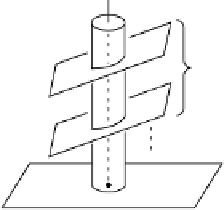Image Processing Reference
In-Depth Information
8
!!
!!!
8
8
8
Fig. 7.5.
Calculation of a density value in projection.
In the subsequent part we call the first case a
weighted sum projection
,and
the second case
weighted maximum intensity projection
. They are simply re-
ferred to as the
accumulated sum projection
and
maximum intensity projection
(
MIP
), if
w
(
x, y, z
)=
1
,
(
x, y, z
).
Several additional problems should be taken into consideration when ap-
plying them to a digitized image. For example, there may be very few sample
points or voxels on a projection line. One basic idea in this case is as follows.
First, consider a normal line (a line perpendicular to the projection plane) at
each sample point P on the projection plane. Then add density values of vox-
els within a predetermined distance from the normal one. A resultant value is
given to the point P. A formal description will be given as follows (Fig. 7.5).
Let us denote by
l
P
a line perpendicular to the projection plane at a point
P=(
u, v
) on the projection plane and by
f
ijk
adensityvalueatavoxel
(
i, j, k
) of a 3D image. Then, a density value
g
P
of a point P on the projection
plane is given by
∀
g
P
=
w
(
i, j, k
;
u, v
)
f
ijk
(7.4)
where
w
(
i, j, k
;
u, v
) is a weight function determined by coordinate values
(
i, j, k
)and(
u, v
). In many cases
w
(
i, j, k
;
u, v
) is given as a function of the
distance from a point (
i, j, k
) to a line passing a point P and is perpendicu-
lar to the projection plane. A linear interpolation given by Eq. 7.1 is also an
example.
An alternative way is to assume a kind of beam of which the centerline is
a line
l
P
with a constant thickness, and to calculate a weighted sum of density
values of voxels intersecting the beam. A weight used here is determined based
upon the area of the intersection of the beam and of each voxel (Fig. 7.5).
The simplest case is the sum of density values of all voxels intersecting the
line
l
P
without weighting.









Search WWH ::

Custom Search